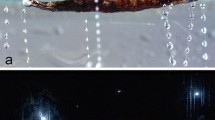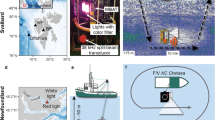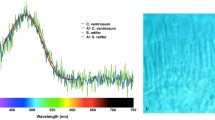Abstract
Specimens of the squid Abralia veranyi were collected off the Bahamas in 1989. The bioluminescence of the ventral photophores was recorded on videotape at 11 to 12°C and 24°C, in conjunction with measurements of the spectral emission at the same temperatures. At 11 °C, the spectrum was unimodal, peaking at 490 nm with a narrow bandwidth. At the higher temperature a shoulder at about 440 nm appeared in the emission spectrum. The short, bright flashes from the subocular photophores had a broader bandwidth and a shorter wavelength emission maximum (475 nm) than that of the ventral photophores. Video recordings at the two temperatures showed no changes in either the identities of the luminescing photophores or their relative intensities. One structurally distinct type of photophore was not illuminated. We conclude that the observed spectral changes were produced within one group of photophores, and that recruitment of the unilluminated photophores would produce an additional spectral component, previously reported from another species of Abralia (A. trigonura).
Similar content being viewed by others
Literature cited
Cooper, K.M., Hanlon, R.T., Budelmann, B.U. (1990). Physiological color change in squid iridophores. II. Ultrastructural mechanisms in Lolliguncula brevis. Cell Tissue Res. 259:15–24
Denton, E.J., Herring, P.J., Widder, E.A., Latz, M.I., Case, J.F. (1985). The roles of filters in the photophores of oceanic animals and their relation to vision in the oceanic environment. Proc. R. Soc. (Ser. B) 225: 63–97
Eckstein, J.W., Cho, K.W., Colepicolo, P., Ghisla, S., Hastings, J.W., Wilson, T. (1990). A time-dependent bacterial bioluminescence emission spectrum in an in vitro single turnover system: energy transfer alone cannot account for the yellow emission of Vibrio fischeri Y-1. Proc. natn. Acad. Sci. U.S.A. 87: 1466–1470
Herring, P.J. (1983). The spectral characteristics of luminous marine animals. Proc. R. Soc. (Ser. B) 220: 183–217
Herring, P.J. (1988). Luminescent organs. In: Trueman, E.R., Clarke, M.R. (eds.). The Mollusca. 11. Academic Press, San Diego, p. 449–489
Latz, M.I., Frank, T.M., Case, J.F. (1988). Spectral composition of bioluminescence of epipelagic organisms from the Sargasso Sea. Mar. Biol. 98: 441–446
Leisman, G., Nealson, K.H. (1982). Yellow light emission in luminous bacteria: purification and properties of a yellow fluorescent protein. In: Massey, V., Williams, C.H. (eds.) Flavins and flavoproteins. Elsevier, New York, p. 383–386
Lythgoe, J.N., Shand, J. (1982). Changes in spectral reflexions from the iridophores of the neon tetra. J. Physiol. 325: 23–34
McElroy, W.D., Seliger, H.H., DeLuca, M. (1974). Insect bioluminescence. In: Rockstein, M. (ed.) The physiology of Insecta. II. Academic Press, New York, p. 411–460
Ruby, E.G., Nealson, K.H. (1977). A luminous bacterium that emits yellow light. Science, N.Y. 196: 432–434
Widder, E.A., Latz, M.I., Case, J.F. (1983). Marine bioluminescence spectra measured with an optical multichannel detection system. Biol. Bull. mar. biol. Lab., Woods Hole 165: 791–810
Widder, E.A., Latz, M.I., Herring, P.J., Case, J.F. (1984). Far-red bioluminescence from two deep-sea fishes. Science, N.Y. 225: 512–514
Young, R.E., Arnold, J.M. (1982). The functional morphology of a ventral photophore from the mesopelagic squid, Abralia trigonura. Malacologia 23: 135–163
Young, R.E., Bennett, T.M. (1988). Photophore structure and evolution within the Enoploteuthinae (Cephalopoda). In: Clarke, M.R., Trueman, E.R. (eds.) The Mollusca, 12. Academic Press, San Diego, p. 241–251
Young, R.E., Mencher, F.M. (1980). Bioluminescence in mesopelagic squid: diel color change during counterillumination. Science, N.Y. 208: 1286–1288
Young, R.E., Seapy, R.R., Mangold, K.M., Hochberg, F.G., Jr. (1982). Luminescent flashing in the midwater squids Pterygioteuthis microlampas and P. giardi. Mar. Biol. 69: 299–308
Author information
Authors and Affiliations
Additional information
Communicated by J. Mauchline, Oban
Rights and permissions
About this article
Cite this article
Herring, P.J., Widder, E.A. & Haddock, S.H.D. Correlation of bioluminescence emissions with ventral photophores in the mesopelagic squid Abralia veranyi (Cephalopoda: Enoploteuthidae). Mar. Biol. 112, 293–298 (1992). https://doi.org/10.1007/BF00702474
Accepted:
Published:
Issue Date:
DOI: https://doi.org/10.1007/BF00702474




